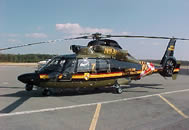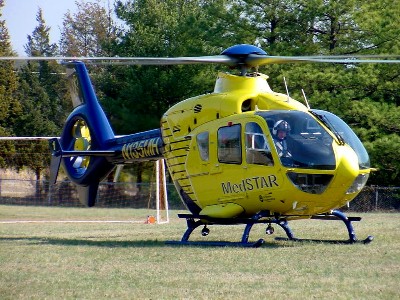Medivac and Medstar Operations
Medivac Operations

The Maryland Department of State Police Aviation Division is responsible for providing aerial support for the department and allied public safety agencies. The Aviation Division was established in 1961 to provide airborne law enforcement and aerial search and rescue capabilities for the citizens of Maryland. On March 19, 1970, the Division's role was expanded after transporting the first critically injured trauma patient.
This created the existing three prong mission profile to include: law enforcement, search and rescue, and medical evacuation of the critically ill and injured. Beginning with one helicopter to cover the entire state, the Aviation Division has grown into eight helicopter sections, a fixed wing section, a maintenance section and various support functions. During the past twenty five years, the Aviation Division has completed over 150,000 law enforcement missions and has transported over 62,000 patients. Trooper 7 is based at the St. Mary’s County Airport. A long term lease arrangement was executed by the St. Mary’s County Commissioners of St. Mary's County on February 1, 1994 and subsequently approved by the State of Maryland Department of General Services Board of Public Works on February 9, 1994. Area leased for use by Trooper 7 meets the Heliport Design criteria specified by FAA Circular 150/5390-2 which includes specified hover- taxi route, runway landing area, location, dimension, markings and pavement design requirements. Trooper 7 transitioned to the new Agusta AW-139 helicopter in CY2014, and a new hangar was constructed in 2010 as a training sight for all MSP aircrews.
| Year | Total Missions 1 | # Medevacs |
|---|---|---|
| 2019 | 53 | 398 |
| 2018 | 57 | 450 |
| 2017 | 53 | 486 |
| 2016 | 56 | 525 |
| 2015 | 58 | 468 |
Source: Maryland State Police Aviation Command Headquarters - Phone: 410-238-5800 | Fax: 410-238-5809.
1 Includes law enforcement/ search and rescue missions
The Aviation Division also operates two fixed wing aircraft. The twin engine airplane is used primarily to return prisoners who are wanted by the State of Maryland. The smaller single engine airplane is used for selected law enforcement missions at a significant cost saving compared to the helicopters. Examples of these missions are aerial photography of a crime or accident scene, surveillance and traffic patrol.
In order to accomplish the three (3) distinct missions , the helicopter flight crews consist of a pilot and a flight paramedic. The flight paramedic is a Trooper who is Nationally Registered Paramedic and possesses the highest level of pre-hospital certification available in Maryland. The pilots are instrument rated and commercially certified with a minimum of 2,000 hours of helicopter flight time. The pilots are a combination of civilian and uniformed employees. To accomplish the varied missions, the Division is supported by a flight training and safety staff, maintenance, inventory, avionics and secretarial staff. Trooper 7, based at St. Mary’s County Regional Airport is pictured above.
The State Police is the only Maryland department performing airborne law enforcement, search and rescue, and aero-medical missions in Maryland.
MedSTAR Operations
In September 2009, the County and the Washington Hospital Center Corporation entered into a lease arrangement for occupancy of a portion of the Captain Walter Francis Duke Terminal Building by MedSTAR (Medical Shock Trauma Acute Resuscitation) in order to enhance responsive health care services and to help reduce medical emergency response time in the Chesapeake Region, Southern Maryland and the citizens of St. Mary's County. The helicopters (American Eurocopters) have cruising speeds of up to 140 knots, have ranges of 180 miles with normal fuel supplies and can respond in inclement weather and low visibility conditions.

MedSTAR provides transportation between hospitals which includes the Washington Hospital Center, Georgetown University Hospital and Children's Hospital National Medical Center. The aircraft carries advanced life support equipment at all times: cardiac and blood pressure monitors, defibrillator, ventilator, oxygen, external pacemakers, IVs and intubations supplies, etc. A standard flight crew consists of a pilot, a critical-care flight nurse and a critical-care paramedic. If needed, additional crew, including a physician or respiratory therapist can be added. Overall, the MedSTAR Transport team has a staff of 80, including pilots, flight nurses, paramedics, communications specialists and mechanics.
Approximately ninety-two percent (92%) of MedSTAR Transport flights are inter-hospital transports of critically ill or critically injured patients, with the remaining eight percent (8%) of flights involving persons who are injured in vehicular accidents. The first MedSTAR Transport flight occurred on July 3, 1983, when a spinal-cord injury patient was flown from Prince William, Virginia Hospital to Washington Hospital Center. MedSTAR was the first hospital-based air medical service in the Washington area and by 2003, nearly 40,000 patients had been safely flown. The initial emphasis of MedSTAR Transport was ferrying trauma patients from the District of Columbia and northern Virginia to Washington Hospital Center. It's current service area extends throughout the mid-Atlantic region - from West Virginia to New Jersey to Pennsylvania to central Virginia.
| Year | Total Missions |
|---|---|
| 2018 | 667 |
| 2017 | 750 |
| 2016 | 881 |
| 2015 | 645 |
